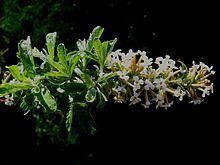Kingdom Plantae Family Buddlejaceae Rank Species | Order Lamiales Genus Buddleja | |
 | ||
Similar Buddleja limitanea, Buddleja crotonoides, Buddleja tibetica | ||
Buddleja × wardii is a naturally occurring hybrid of Buddleja alternifolia and Buddleja crispa discovered and collected by Frank Kingdon-Ward in 1924 from the mountain riverbanks of south-eastern Xizang (formerly Tibet) at altitudes of 3000–3600 m; B. alternifolia and B. crispa are the only other Buddleja species found in the area. The shrub was named for Ward by Cecil Marquand in 1929. White-flowering plants under this name were collected in Tibet by Keith Rushforth and introduced to commerce in the UK in 2013.[1]
Contents
Description
Buddleja × wardii is a shrub 1–5 m tall, with stellate tomentose glabrescent branchlets bearing leaves arranged both opposite and alternate, the blade elliptic to subelliptic, 0.5–5.0 × 0.3–2.0 cm, shortly stellate tomentose, margin repand-crenate, the apex acuminate to acute. The terminal inflorescences are cymose, 1.5–2.0 cm in diameter, comprising pale lilac or white flowers with orange throats; the corolla tubes about 7 × 2 mm. The shrub flowers in April in southern England.
Cultivation
The hybrid is very rare in cultivation, and not held by any of the 27 major American and European botanical gardens and arboreta linked to the RBG Edinburgh multisite search engine.[2] In the UK, the plant is grown at the NCCPG National Collection of Buddleja at the Longstock Park Nursery, near Stockbridge, and the Ventnor Botanic Garden on the Isle of Wight. Hardiness: USDA zones 8–9.
